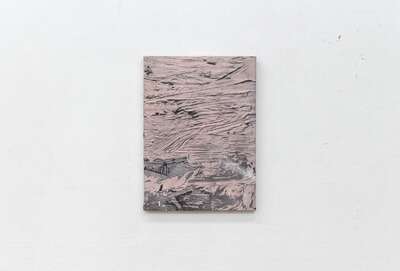KEKE VILABELDA – OVERWRITE SERIES
FEBRUARY 7 - MARCH 11, 2017
The works of Keke Vilabelda (Valencia, Spain, 1986) are the records of a rambler. In this way, the artist connects with a genealogy of urban landscapers that begin precisely in the Impressionism. Those views where the ironwork of the new bridges over the Seine River or the lustrous cobblestones of Parisian streets are finally the protagonists of Impressionist painting, as happens in Gustave Cailleboite's Street of Paris on a Rainy Day in 1877, where the grid of the paving after a rainy day half of the fabric dominates.
Just as the Impressionists focused on the details of the modern city, other flâneurs fixed their gaze on textures like this one in the French capital. I think of the artists who aimlessly and according to the Debordian drifts they walked through their cities collecting their impressions (pun intended): Arman collecting waste to fill the void of the Iris Clert gallery or the monumental industrial paint canvases of that other foundational situationist as was Giuseppe Pinot-Gallizio.
In short, Vilabelda is linked to a multifaceted tradition of urban impressionists. This idea that derives from printing is relevant, since this artist does nothing other than transpose epidermally, frames and structures that they define the modern city and from these skins, establish a correspondence with another skin - that of painting, which is also and as we know, a layer that covers a surface.
These dialogues between the city and painting occur in this artist's work from a game of overlapping appointments. As if writing an essay, Keke Vilabelda inserts his references in the two-dimensional plane of painting-photography-stamp. Not for nothing has he entitle Overwrite, which means precisely overwriting, this series of recent pieces. The artist writes, through a set of cited images, an account of the displacement of the city towards its fragments, which rise up in the work like mementos mori of what covers the city, traversed by the poetic coldness of a minimal compositional movement, simply based on the edition, and at the same time by an imperceptible intervention of the artist-gatherer. A very elegant and precise artistic operation where the idea of the trompe l'oeil also flies above not only from the duplication of the ruinous, epidermal pieces of the modern city but also from the simulation of the artistic techniques that Keke Vilabelda masters impeccably, where we see a graffiti we actually see a frottage and where a photograph appears it is transformed into a very thin layer of paint. This artist shows us, as Cailleboite did in 1877, the elegant beauty of the skins of the pictorial and of the city from his visual writings.
Carlos Palacios
Curador
Las obras de Keke Vilabelda (Valencia, España, 1986) son los registros de un paseante. De esta manera, el artista se enlaza con una genealogía de paisajistas urbanos que comienzan precisamente en el impresionismo. Aquellas vistas donde los hierros de los novedosos puentes sobre el río Sena o los lustrosos adoquines de las calles parisinas son finalmente los protagonistas de la pintura impresionista, como sucede en Calle de París en un día de lluvia de 1877 de Gustave Cailleboite, donde la cuadrícula del empedrado después de un día de lluvia domina la mitad de la tela.
Así como los impresionistas se detuvieron en los detalles de la ciudad moderna, otros flâneurs fijaron la mirada en texturas como ésta de la capital francesa. Pienso en los artistas que sin rumbo fijo y de acuerdo a las derivas Debordianas
caminaban por sus urbes recogiendo sus impresiones (nunca mejor dicho): Arman recolectando desechos para llenar el vacío de la galería de Iris Clert o las monumentales telas de pintura industrial de ese otro situacionista fundacional como fue Giuseppe Pinot-Gallizio.
En fin, Vilabelda se engarza con una poliédrica tradición de impresionistas de lo citadino. Es relevante esta idea que deriva de la impresión, pues este artista no hace otra cosa que transponer de manera epidérmica, tramas y estructuras que
definen a la ciudad moderna y desde estas pieles, establecer una correspondencia con otra piel – la de la pintura, que es también y como sabemos, una capa que recubre una superficie-.
Estos diálogos entre la ciudad y la pintura ocurren en la obra de este artista desde un juego de citas que se sobreponen. Como si escribiera un ensayo, Keke Vilabelda inserta sus referencias en el plano bidimensional de la pintura-fotografía-
estampa. No en balde ha intitulado overwrite, que significa precisamente sobre-escritura, a esta serie de piezas recientes. El artista va escribiendo, a través de un juego de imágenes citadas, un relato del desplazamiento de la ciudad hacia sus fragmentos, que se alzan en la obra como unos mementos mori de lo que recubre a la ciudad, atravesados por la poética frialdad de un mínimo movimiento compositivo, simplemente basado en la edición, y a la vez por una imperceptible intervención del artista-recolector. Una operación artística muy elegante y precisa donde igualmente sobrevuela la idea del trompe l’oeil no sólo desde la duplicación de los trozos ruinosos, epidérmicos, de la ciudad moderna sino igualmente desde la simulación de las técnicas artísticas que de manera impecable domina Keke Vilabelda, donde vemos un graffiti en realidad vemos un frottage y donde aparece una fotografía esta se trasforma en una finísima capa de pintura. Este artista nos muestra, como lo hiciera Cailleboite en 1877, la belleza elegante de las pieles de lo pictórico y de la ciudad desde sus escrituras visuales.
Carlos Palacios
Curador














